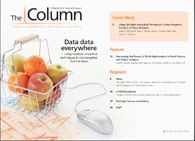TB detection
A new method has been developed for the identification and classification of various tuberculosis (TB) causing and non-TB Mycobacterium species on the basis of their characteristic metabolite profiles
A new method has been developed for the identification and classification of various tuberculosis (TB) causing and non-TB Mycobacterium species on the basis of their characteristic metabolite profiles.1
A modified Bligh-Dyer extraction procedure was used to extract lipid components from Mycobacterium tuberculosis, M. avium, M. bovis and M. kansasii cultures. Principle component analyses (PCA) were applied to the GC–MS generated data and showed a clear differentiation between all the species tested. The twelve compounds that best showed the variation between the sample groups were identified and classed as potential metabolite markers, using PCA and partial least-squares discriminant analysis (PLS–DA). These markers were then used to build a Bayesian statistical classification model. The model identified 2 ‘unknown’ samples for each of the Mycobacterium species analysed, with probabilities ranging from 72–100%.
The test had the advantage of speed and could be performed in under 16 h. The detection limit was 1 × 103 bacteria mL21.
The study concluded that there was potential for a GC–MS, metabolomics pattern recognition approach to be used in TB diagnosis.
1. D. Toots et al., Journal of Microbiological Methods, 88(3), 419–426 (2012).
This story originally appeared in The Column. Click here to view that issue.
Determining the Effects of ‘Quantitative Marinating’ on Crayfish Meat with HS-GC-IMS
April 30th 2025A novel method called quantitative marinating (QM) was developed to reduce industrial waste during the processing of crayfish meat, with the taste, flavor, and aroma of crayfish meat processed by various techniques investigated. Headspace-gas chromatography-ion mobility spectrometry (HS-GC-IMS) was used to determine volatile compounds of meat examined.

.png&w=3840&q=75)

.png&w=3840&q=75)



.png&w=3840&q=75)



.png&w=3840&q=75)







